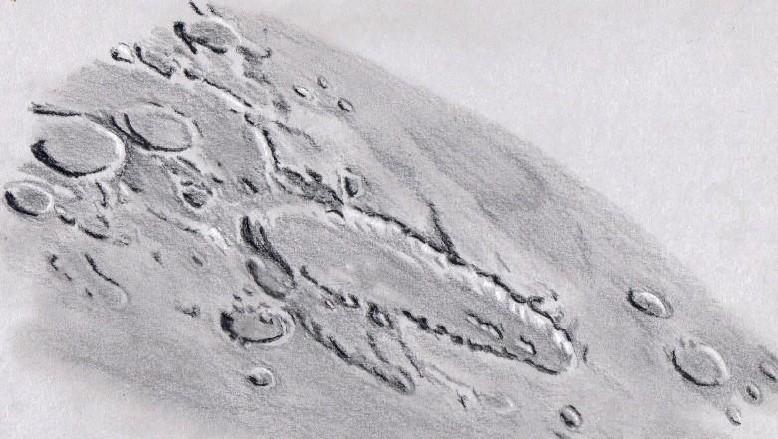
Crater Schiller
Sketch and Details by Frank McCabe
Crater Schiller
Looking much like the outline of the famous paramecium protozoan from high school biology class, crater Schiller is an elongated Nectarian period feature (3.7 billion years old) and a standout in the highlands of the southwestern quadrant. This crater is oriented southeast to northwest and measures 180 kilometers long and 70 kilometers at its widest. The floor is mostly flat and lava flooded with two short lines of mountains to the northwest. The illuminated inner wall displayed ridges and terraces at the eyepiece. South and west is the Schiller Annular Plain near the edge of the Schiller-Zucchius basin’s outermost ring. How this crater came to have such an elongated shape has been the subject of several speculative hypotheses. The front runner as to a cause that produced the elongated shape is the gradual descent of a lunar moonlet that struck the moon at high velocity breaking into pieces before the grazing angle impact. The lunar orbiter images of this crater look like the coalescence of three combined impacts. East of Schiller you see craters Rost (51 km.) and Rost A (39 km.). Just north of Schiller is crater Bayer (49 km.) with a small craterlet on its southern floor.
Point your telescope at Schiller on the next moon filled night and have a first hand look.
Sketching:
For this sketch I used: off-white copy paper 8.5”x 11”, 2H, HB, 4B graphite pencils, also a white pastel pencil, eraser shield and pink pearl eraser at the eyepiece.
Telescope: 10 inch f/ 5.7 Dobsonian and 9mm eyepiece 161x
Date: 11-11-2006 1:20-2:30 UT
Temperature: 10°C (50°F)
Clear 0°C (32° F)
Seeing: Antoniadi III
Colongitude: 65.5 °.
Lunation: 13 days
Illumination: 93.2 %

Very nice effect of depth there in Schiller Frank. It is good to see one of your ‘older’ lunar sketches, there has been a great deal of evolution in your style since then.
Warm regards, Dale
Thank you Dale, I appreciate the nice words.
Frank